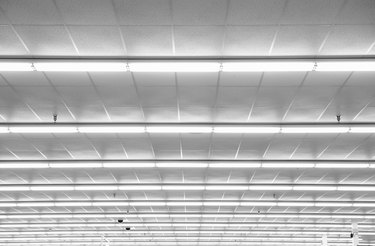
Fluorescent lightbulbs, which are increasingly favored over incandescent lightbulbs because they use a lot less electricity to produce light, typically contain an inert gas, like argon, along with mercury, which generates light. Compact fluorescent lightbulbs (CFL) are the most common type. While mercury is a toxic gas that can harm animals and humans, CFLs are safe to handle and use around the home as long as they are not broken.
Mercury in Fluorescent Lightbulbs
Video of the Day
Traditional incandescent lightbulbs work by running an electric current through a wire filament. When the filament heats up, it glows, and this mechanism produces visible light. In fluorescent lightbulbs, on the other hand, an electric current runs through a tube that contains a mixture of argon and mercury gases and produces ultraviolet light. A coating of phosphorus around the tube converts that ultraviolet light into visible light. A fluorescent lightbulb uses around a quarter of the electricity used by incandescent lightbulbs.
Video of the Day
According to the United States Environmental Protection Agency (EPA), on average, a CFL contains about 4 milligrams of mercury inside the glass tube. This level of mercury poses no threat to human health as long as the glass remains intact. However, if the lightbulb breaks, the mercury is released. CFLs should therefore be handled with care when you are removing them from their packaging, installing them or replacing them.
Fluorescent Lightbulb Safety
The EPA has established guidelines in the event that a CFL should break. The goal is to reduce the exposure to mercury as much as possible. All people and animals should leave the room right away. Then, you should open a window and leave it open for 15 minutes at the very least to help ventilate the space. If you have a central air conditioning or heating system in your home, shut it off immediately. It is best not to use these systems for a few hours.
Brooms and vacuum cleaners should not be used to clean up fragments of a fluorescent lightbulb, as they can actually break up the mercury and disperse it further. Instead, after you have ventilated the area as much as possible, put on protective gloves and use a piece of paper or some cardboard to remove the glass fragments from hard floors or carpet. Pick up any small remaining pieces of glass using sticky tape. Put the fragments inside a container with a lid to be disposed of properly. Place the jar in an outdoor garbage receptacle, discard the gloves and wash your hands thoroughly.
Disposing of Fluorescent Lightbulbs
When released into the environment, mercury can become a pollutant if it evaporates into the air or ends up in the water supply. Therefore, the EPA does not recommend disposing of burnt-out fluorescent lightbulbs along with the rest of your household trash, as this can lead to the mercury ending up in a landfill. Instead, you should take burn-out CFLs to a local recycling center. Recycling lightbulbs is also a good practice because some parts of fluorescent lightbulbs can often be reused.